Why farmers love the Orange Elephant tomato so much
Orange elephant - tomatoes with an original orange color, sweet and fleshy pulp. The variety is loved by gardeners for its ease of care, long-term fruiting and the ability to ripen outside the bushes. In the article we will talk about the advantages and disadvantages of the variety, the features of agricultural technology in the greenhouse and vegetable garden.
Characteristics and description of the variety
The mid-early tomato variety Orange Elephant is a product of the selective work of the Gavrish seed company. It was included in the State Register of Russia in 2011. The culture was created for cultivation in film-type greenhouses in all regions of the country. Suitable for cultivation in the south in unprotected soil.
The bushes are determinate: in closed ground they reach 1 m, in open ground - 70 cm. The plant does not need frequent pinching. As they grow, young shoots are removed and a bush of 1-2 stems is formed. Stems with heavy fruits are tied to stakes or trellises.
The photo shows Orange elephant tomatoes.
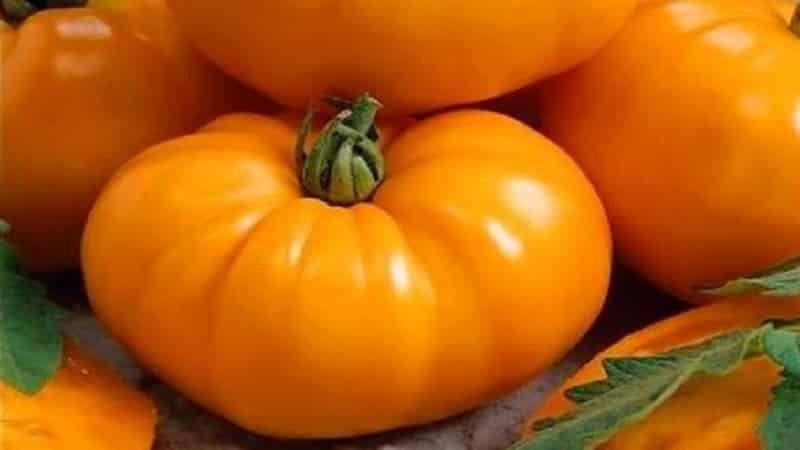
The table summarizes cultural features:
| Options | Characteristics |
| Ripening time | 100–110 days after germination. |
| Leaves | Medium size, light green. |
| Fruit shape | Rounded. |
| Weight | 130–160 g. |
| Type of inflorescences | Simple. |
| Number of slots | 3-4. |
| peduncle | With articulation. |
| Skin | Smooth thin. |
| Coloring | Orange. |
| Pulp | Medium density. |
| Taste | Sweet pleasant. |
| Harvest from 1 m² | 5-6 kg. |
| Transportability | High. |
Growing seedlings
Preparation of seeds for seedlings begins 50–65 days before transferring to the ground:
- in the northern regions - in early April;
- in the regions of the middle zone - in mid-March;
- in the south - in early March.
Seed preparation
Experienced farmers advise updating planting material annually and not using seeds from previously grown tomatoes. Before sowing, preliminary disinfection of grains is carried out in a pink solution of potassium permanganate (30 minutes) or in a 2% peroxide solution (10 minutes).
To stimulate germination, seeds are soaked in special preparations. The most popular are “Epin”, “Zircon”, “Immunocytophyte”, “Baikal”.
The soil
The soil for tomato seedlings should be light and nutritious. A mixture of turf soil, peat and river sand in equal parts is suitable. As fertilizers, 40 g of superphosphate and 15 g of potassium are added to 10 liters of water.
Instead of soil made with your own hands, use a ready-made balanced substrate for tomatoes.
Both mixtures need to be sanitized in the oven or microwave. In practice, a quick and effective disinfection method is often used - watering with a strong solution of potassium permanganate.
Sowing
Containers for seedlings no more than 7 cm high are filled with a moist substrate and seeds are placed in it to a depth of 1.5 cm with an interval of 2 cm. Sprinkle the top with a layer of earth (1 cm) and cover with glass or plastic film. The future seedlings are taken to a dark place. Shoots appear at a temperature of +23 °C in 4–6 days.
Seedling care
After the first leaves appear, the film or glass is removed and the containers are placed on the windowsill on the south side. Seedlings like moderate watering no more than once a week.
Seedlings are fed once every 15 days with ready-made fertilizers according to the instructions on the package: Agricola, BioMaster, Biohumus. The complexes contain a large amount of nitrogen necessary for rapid crop growth and green mass gain.It is important not to overdo it here, otherwise the root system will “burn out.”
Advice. After watering, “dust” the soil with wood ash for additional nutrition of the greenery.
With the appearance of 2-3 true leaves, the seedlings are planted in individual plastic or peat containers.
A week before moving to a permanent place, the plants are taken out into fresh air for hardening. Starting with 1 hour of being outside, the time is gradually increased to the whole daylight hours.
Principles of agricultural technology
Orange elephant tomatoes are easy to care for. For active fruiting during cultivation in the garden and greenhouse, it is enough to adhere to the correct regime of watering, fertilizing, loosening the soil or mulching.
Landing
50–65 days after emergence, the strengthened seedlings are transferred:
- to the garden - in the last ten days of May or the first ten days of June;
- to the greenhouse - in the 1-2 decades of May.
Young plants must have a strong stem and strong rhizome, one flower ovary, and a height of at least 30 cm.
Planting pattern - 40x60 cm, no more than 2-3 bushes per 1 m².
For planting, choose a cloudy, windless day or wait until the evening. The seedlings are moistened abundantly, and the lower and yellow leaves are torn off.
The soil is loosened and fertilized with compost or humus mixed with ash (1 bucket per 1 m²). The holes are dug at a depth of 20 cm and filled with boiling water or a concentrated solution of potassium permanganate.
The seedlings are carefully moved along with the earthen ball, the soil is compacted and covered with mulch. The bushes are immediately tied to wooden stakes in the garden or trellises in the greenhouse.
Care
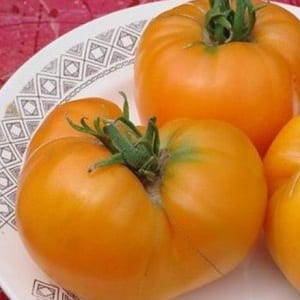
Fruiting of the Orange Elephant depends on proper watering. Plants are watered infrequently, but abundantly, until the soil is completely dry.
Water is poured strictly under the roots, and the above-ground part is irrigated with a spray bottle in the evening. This reduces the risk of fungal infection. At the initial stage of growth, about 5 liters of water per 1 m² are used. Flowering and fruiting bushes require at least 10 liters per 1 m².
Despite their short stature, tomatoes need to form bushes with 2 stems. To do this, young shoots are removed, leaving only one stepson growing from the leaf axil at the very bottom. This allows you to achieve higher yields.
Mulching the soil with sawdust, pine needles, agrofibre, hay, and straw eliminates routine loosening and weeding after each watering.
After transferring the seedlings to a permanent place, fertilizers are applied every 14-15 days:
- infusion of chicken manure in a ratio of 1:20 - 2 weeks after planting;
- nitrophoska solution (60 g of substance per 10 liters of water) - for subsequent fertilizing.
Plants respond well to ready-made fertilizers: “Red Giant”, “Biohumus”, “Agricola”, “Effecton-O”.
Diseases and pests
The Orange Elephant variety cannot boast of strong immunity: plants are often attacked by a fungus if not properly cared for. At the genetic level, the crop is protected from verticillium and fusarium.
A particular danger to tomatoes is late blight, powdery mildew, cladosporiosis.
Signs of late blight:
- brown-gray spots on leaves and stems;
- whitish coating on the back of the leaves;
- spots on fruits and their deformation.
Signs of powdery mildew:
- white-yellow coating on leaves and stems;
- small brown dots (spores);
- drops of dew on greenery;
- leaves curled up.
Signs of cladosporiosis, or brown spot:
- yellow spots on leaves;
- brown coating on their underside.
For prevention, bushes are treated with fungicides (Ridomil Gold, Oxychom, HOM) before flowering and ovary formation, once every 20 days.
The drugs Fitosporin, Fitoflavin, and Bravo are safe and effective in the fight against fungi. Bushes are treated once every 2 weeks.
Preventive measures are no less effective:
- disinfection of greenhouses with sulfur bombs;
- soil treatment with copper sulfate;
- removing the lower leaves of plants;
- timely feeding with phosphorus and potassium;
- soil mulching;
- normalization of humidity in the room through ventilation.
“Fitoverm”, “Flumite”, “Grom”, “Strela”, “Konfidor”, “Aktara”, “Borneo” will help fight aphids, whiteflies, spider mites, and Colorado potato beetles.
The nuances of growing in open and closed ground
The crop grows and bears fruit better in soil with neutral acidity (pH=7). To determine the indicator, litmus strips or a special device with a probe are used. Wood ash will help balance acidity:
- at higher values, add 400–500 g per 1 m²;
- for medium - 200–300 g 1 m²;
- at low temperatures - 200 g per 1 m².
To maintain the optimal level of humidity after spraying the bushes, the windows and doors in the greenhouse are kept open.
Tomatoes ripen faster at a room temperature of +18...+25 °C during the day, and +15...+18 °C at night.
Harvesting and application
The fruiting period of the Orange Elephant is extended, which allows you to enjoy the excellent taste of the fruit longer. To increase productivity, tomatoes are harvested at the stage of milky ripeness and left to ripen in boxes.
The fruits are used to prepare seasonal vegetable salads and snacks. They produce delicious tomato juice with an original color.Fully ripe tomatoes are suitable for adjika, sauces, and vegetable caviar. Small fruits are suitable for canning entirely.
Advantages and disadvantages of the variety
Advantages of culture: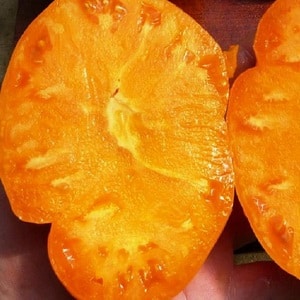
- sweet pleasant taste of fruits;
- juicy fleshy pulp;
- ease of care;
- possibility of growing in open and closed ground;
- long fruiting;
- excellent transportability;
- a large amount of vitamins A, C, beta-carotene in the pulp;
- possibility of ripening outside the bush.
Flaws:
- low yield compared to other varieties of the variety;
- the need for pinching and gartering;
- predisposition to fungal diseases.
Other varieties of the variety
In addition to the Orange Elephant, there are several types of this tomato variety.
Yellow elephant
An early ripening variety for greenhouse cultivation.
| Options | Characteristics |
| Ripening time after germination | 100–105 days. |
| Leaves | Medium size, green. |
| Fruit shape | Flat-round, medium ribbed. |
| Weight | 300–350 g. |
| Type of inflorescences | Intermediate. |
| peduncle | With articulation. |
| Skin | Dense. |
| Coloring | Yellow. |
| Pulp | Medium density. |
| Taste | Sweet pleasant. |
| Harvest from 1 m² | 16-17 kg. |
Red elephant
An early ripening variety for film greenhouses.
| Options | Characteristics |
| Ripening time after germination | 100–105 days. |
| Leaves | Medium size, green. |
| Fruit shape | Flat-round, medium ribbed. |
| Weight | 300–350 g. |
| Type of inflorescences | Simple. |
| peduncle | With articulation. |
| Skin | Dense, but not rigid. |
| Coloring | Red. |
| Pulp | Fleshy and sugary. |
| Taste | Sweet pleasant. |
| Harvest from 1 m² | 12-13 kg. |
Raspberry elephant
Early ripening variety for closed ground.
| Options | Characteristics |
| Ripening time after germination | 110–115 days. |
| Leaves | Medium size, green. |
| Fruit shape | Round, slightly ribbed. |
| Weight | 300–600 g. |
| Type of inflorescences | Simple. |
| peduncle | With articulation. |
| Skin | Thin and easy to separate. |
| Coloring | Pink. |
| Pulp | Medium density. |
| Taste | Sweet. |
| Harvest from 1 m² | 6–8 kg. |
Pink Elephant
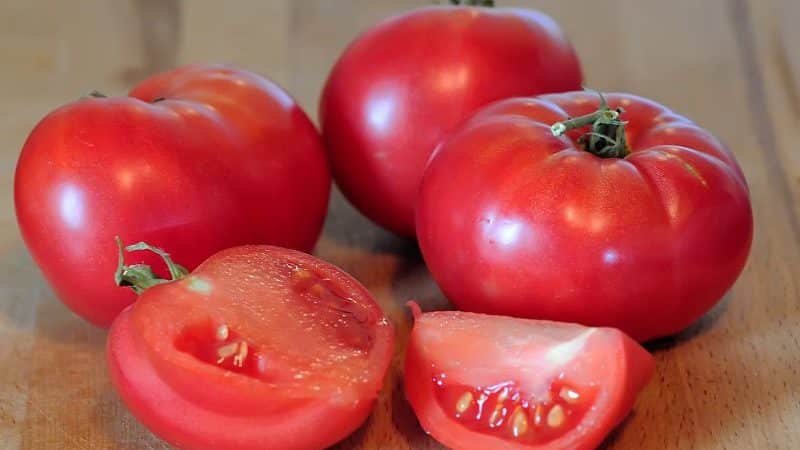
Mid-season variety for closed ground.
| Options | Characteristics |
| Ripening time after germination | 112–115 days. |
| Leaves | Potato type, medium size, green. |
| Fruit shape | Flat-round, strongly ribbed, apex with a notch. |
| Weight | 250–300 g. |
| Type of inflorescences | Intermediate. |
| peduncle | With articulation. |
| Skin | Dense, but not rigid. |
| Coloring | Pink with a green spot. |
| Pulp | Meaty. |
| Taste | Sweet without sourness. |
| Harvest from 1 m² | 6–8 kg. |
Black elephant
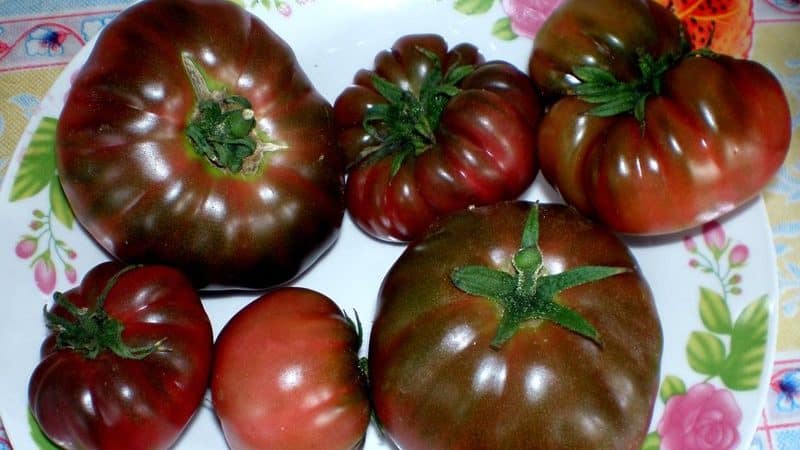
Mid-season variety for protected and unprotected soil.
| Options | Characteristics |
| Ripening time after germination | 110–115 days. |
| Leaves | Large green. |
| Fruit shape | Flat-round, strongly ribbed. |
| Weight | 190–350 g. |
| Type of inflorescences | Intermediate. |
| peduncle | With articulation. |
| Skin | Thin. |
| Coloring | Black-brown with a green spot near the stalk. |
| Pulp | Meaty. |
| Taste | Sweet with sourness. |
| Harvest from 1 m² | 7–9 kg |
Sugar elephant
The variety was bred by Russian breeders in 1989 for greenhouses in the northern regions and open ground in the south.
| Options | Characteristics |
| Ripening time after germination | 110–115 days. |
| Leaves | Large green. |
| Fruit shape | Flat-round. |
| Weight | 300–600 g. |
| Type of inflorescences | Intermediate. |
| peduncle | With articulation. |
| Skin | Thin smooth. |
| Coloring | Pink. |
| Pulp | Meaty. |
| Taste | Sweet. |
| Harvest from 1 m² | 4–6 kg. |
Farmer reviews
Those who tried to grow the Orange Elephant variety on their plots were satisfied with the harvest and taste of the fruit:
Olga, Olkhovatka village, Voronezh region: «I planted this variety in the garden last year. Before this, I read reviews from summer residents. It was hot outside, but the plants withstood the drought. From each bush I collected about 5 kg of selected tomatoes. The color turned out not bright orange, like in the picture, but yellow. The taste is excellent, sweet without sourness.”
Victor, Krasnaya Yaruga village, Belgorod region: “I prefer to plant Orange Elephant tomatoes in a film greenhouse. I grow them for myself; everyone at home likes their rich taste and bright color. We eat only fresh. The yield is low, but it bears fruit steadily until the end of August.”
Conclusion
Even a gardener without experience can handle the cultivation of Orange Elephant tomatoes. The culture is easy to care for and requires only moderate watering and timely fertilizing. Feels great indoors and outdoors, in dry and cool climates.
The disadvantages include a weak level of protection against fungal infections, which can be combated by spraying with fungicides (Ridomil Gold, Oxychom, HOM) and preventive measures.